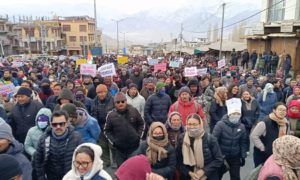Srinagar: An August report by NITI Aayog has revealed that Jammu and Kashmir is among the worst in the Indian Himalayan Region (IHR) when it comes to maintaining a balance between environment and tourism, The Kashmir Monitor reported.
The Himalayan region covers 5,33,000 square kilometres across 10 mountain states including J&K, Uttarakhand, Himachal Pradesh, Sikkim, Arunachal Pradesh, Meghalaya, Manipur, Mizoram, Nagaland and Tripura, and the hill districts of Dima Hasao (Assam) and Karbi Anglong (Darjeeling) and Kalimpong (West Bengal).
The report titled, ‘Report of Working Group II, Sustainable Tourism in the Indian Himalayan Region’, discloses that the state is not investing in tourism despite the potential and earnings from the sector.
The total state expenditure on tourism in 2017, the report shows, was Rs 14.73 crore, a mere 0.03 per cent of the state’s total Rs 48,819-crore expenditure.
J&K was placed third among the IHR states with least investment on tourism.
The report also compared the little investment in the tourism sector by J&K with the ever-increasing flow of tourists and the haphazard way of handling it.
The report stated how the average use of water by a local resident in Ladakh was 25 litres a day, was in contrast to a tourist who uses up 75 litres per day.
“Similarly there are hotels which consume up to 5,000 litres of water per day and each year 20 to 25 such hotels are being registered in the Ladakh region,” the report says, adding, “Sustainable tourism investment needs in this vulnerable landscape have grown drastically.”
It observes how waste management has been a huge challenge in IHR and will become much more threatening as the number of tourists grows.
J&K, here as well, fares poorly, with 0.14 gm per capita per day solid waste generation, the second worst in the region after Mizoram.
The state saw more than 5.8 crore tourist arrivals between 2011 and 2015.
However, it has so far failed in scientific waste management and has faced repeated censuring by National Green Tribunal.
“It also needs underlining that due to different microclimates and inaccessibility, waste disposal or decomposition in the mountains is either long term or it drains into rivulets endangering aquatic life and quality of regulatory services (e.g. drinking water quality) downstream,” the report read.
In Environmental Performance Index (EPI), the report shows J&K putting a very bleak show in indices Air and Water pollution, Forests, Waste Management and Climate Change vis-à-vis all the states of India with a final EPI rank of 22.
In a World Bank survey in 2015, which used criteria such as ‘Ease of doing Business and Environmental Compliance’, the report says that none of the IHR states figured in the top 10.
“It indicates that the environment for tourism business is not necessarily favourable in the IHR and that despite the fragility of the IHR landscape, environmental compliance may have been compromised,” the report added.






